
The Great Internet Mersenne Prime Search (GIMPS) is a collaborative project of volunteers who use freely available software to search for Mersenne prime numbers.

A supercomputer is a type of computer with a high level of performance as compared to a general-purpose computer. The performance of a supercomputer is commonly measured in floating-point operations per second (FLOPS) instead of million instructions per second (MIPS). Since 2022, supercomputers have existed which can perform over 1018 FLOPS, so called exascale supercomputers. For comparison, a desktop computer has performance in the range of hundreds of gigaFLOPS (1011) to tens of teraFLOPS (1013). Since November 2017, all of the world's fastest 500 supercomputers run on Linux-based operating systems. Additional research is being conducted in the United States, the European Union, Taiwan, Japan, and China to build faster, more powerful and technologically superior exascale supercomputers.
Grid computing is the use of widely distributed computer resources to reach a common goal. A computing grid can be thought of as a distributed system with non-interactive workloads that involve many files. Grid computing is distinguished from conventional high-performance computing systems such as cluster computing in that grid computers have each node set to perform a different task/application. Grid computers also tend to be more heterogeneous and geographically dispersed than cluster computers. Although a single grid can be dedicated to a particular application, commonly a grid is used for a variety of purposes. Grids are often constructed with general-purpose grid middleware software libraries. Grid sizes can be quite large.
Floating point operations per second is a measure of computer performance in computing, useful in fields of scientific computations that require floating-point calculations.

The Berkeley Open Infrastructure for Network Computing is an open-source middleware system for volunteer computing. Developed originally to support SETI@home, it became the platform for many other applications in areas as diverse as medicine, molecular biology, mathematics, linguistics, climatology, environmental science, and astrophysics, among others. The purpose of BOINC is to enable researchers to utilize processing resources of personal computers and other devices around the world.

LHC@home is a volunteer computing project researching particle physics that uses the Berkeley Open Infrastructure for Network Computing (BOINC) platform. The project's computing power is utilized by physicists at CERN in support of the Large Hadron Collider and other experimental particle accelerators.

Within the BOINC platform for volunteer computing, the BOINC Credit System helps volunteers keep track of how much CPU time they have donated to various projects. This ensures users are returning accurate results for both scientific and statistical reasons.
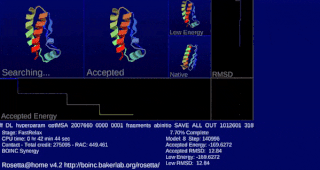
Rosetta@home is a volunteer computing project researching protein structure prediction on the Berkeley Open Infrastructure for Network Computing (BOINC) platform, run by the Baker lab. Rosetta@home aims to predict protein–protein docking and design new proteins with the help of about fifty-five thousand active volunteered computers processing at over 487,946 GigaFLOPS on average as of September 19, 2020. Foldit, a Rosetta@home videogame, aims to reach these goals with a crowdsourcing approach. Though much of the project is oriented toward basic research to improve the accuracy and robustness of proteomics methods, Rosetta@home also does applied research on malaria, Alzheimer's disease, and other pathologies.
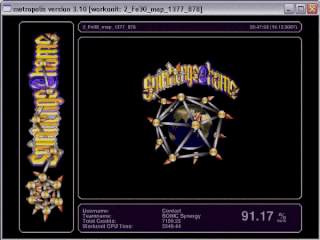
Spinhenge@home was a volunteer computing project on the BOINC platform, which performs extensive numerical simulations concerning the physical characteristics of magnetic molecules. It is a project of the Bielefeld University of Applied Sciences, Department of Electrical Engineering and Computer Science, in cooperation with the University of Osnabrück and Ames Laboratory.

Volunteer computing is a type of distributed computing in which people donate their computers' unused resources to a research-oriented project, and sometimes in exchange for credit points. The fundamental idea behind it is that a modern desktop computer is sufficiently powerful to perform billions of operations a second, but for most users only between 10–15% of its capacity is used. Common tasks such as word processing or web browsing leave the computer mostly idle.

ABC@Home was an educational and non-profit network computing project finding abc-triples related to the abc conjecture in number theory using the Berkeley Open Infrastructure for Network Computing (BOINC) volunteer computing platform.
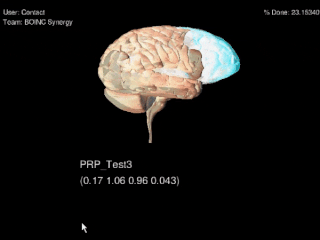
MindModeling@Home is an inactive non-profit, volunteer computing research project for the advancement of cognitive science. MindModeling@Home is hosted by Wright State University and the University of Dayton in Dayton, Ohio.
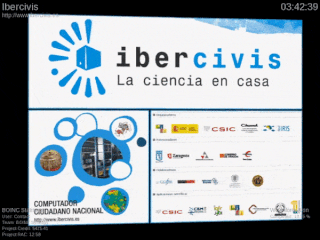
Ibercivis was a volunteer computing platform which allows internet users to participate in scientific research by donating unused computer cycles to run scientific simulations and other tasks. The original project, which became operational in 2008, was a scientific collaboration between the Portuguese and Spanish governments, but it is open to the general public and scientific community, both within and beyond the Iberian Peninsula. The project's name is a portmanteau of Iberia and the Latin word civis, meaning 'citizen'.

MilkyWay@home is a volunteer computing project in the astrophysics category, running on the Berkeley Open Infrastructure for Network Computing (BOINC) platform. Using spare computing power from over 38,000 computers run by over 27,000 active volunteers as of November 2011, the MilkyWay@home project aims to generate accurate three-dimensional dynamic models of stellar streams in the immediate vicinity of the Milky Way. With SETI@home and Einstein@home, it is the third computing project of this type that has the investigation of phenomena in interstellar space as its primary purpose. Its secondary objective is to develop and optimize algorithms for volunteer computing.

Róbert Lovas is a Hungarian computer scientist at SZTAKI, Budapest, Hungary.
The SHIWA project within grid computing was a project led by the LPDS of MTA Computer and Automation Research Institute. The project coordinator was Prof. Dr. Peter Kacsuk. It started on the 1st of July 2010 and lasted two years. SHIWA was supported by a grant from the European Commission's FP7 INFRASTRUCTURES-2010-2 call under grant agreement n°261585.
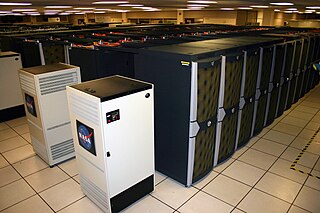
Quasi-opportunistic supercomputing is a computational paradigm for supercomputing on a large number of geographically disperse computers. Quasi-opportunistic supercomputing aims to provide a higher quality of service than opportunistic resource sharing.
The Generic Grid-Grid (3G) Bridge is an open-source core job bridging component between different grid infrastructures. Its development started in 2008 within the CancerGrid and EDGeS projects. The aim was to create a generic bridge component that can be used in different grid interoperability scenarios. The 3G Bridge used within the EDGeS project that provides the core component of the Service Grid - Desktop Grid interoperability solution. 3G Bridge helps to connect user communities of different grid systems. For example, communities working on parameter sweep problems and using service grid infrastructures can migrate their applications to the more adequate desktop grid platform using the 3G Bridge technology, resulting in an accelerated research.

OProject@Home was a volunteer computing project running on the Berkeley Open Infrastructure for Network Computing (BOINC) and was based on a dedicated library OLib. The project was directed by Lukasz Swierczewski, an IT student at the College of Computer Science and Business Administration in Łomża, Computer Science and Automation Institute. As of 2016 it seems to have been abandoned.
















